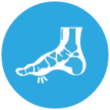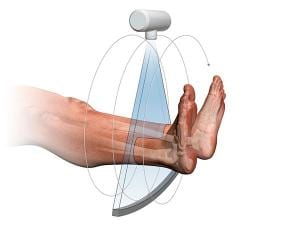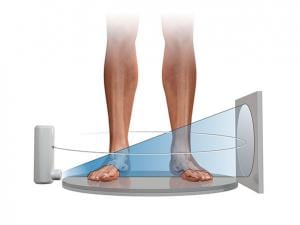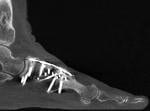By default, CurveBeam AI weight-bearing axial images will be oriented based on the DICOM anatomical model, looking up from the plantar surface of the feet, so the bottom of the foot is standing on the platform at the base of the machine.
As patients are standing on a platform parallel to the rotation axis of the at panel detector, the axial slices will align with the base of the foot. With the InReach, the same DICOM anatomical model is used for setting the image orientation, hence upper extremity scans will always have the fingers pointing down in any third-party viewing software. Prone, supine, and decubitus left/right orientation is selected by the operator on the device prior to a scan, which is based on how the operator positions the patient on the positioning platform (similar to the table in a MDCT).
With the InReach, the hand, wrist, or elbow is typically inserted straight into the bore, so the long bones are parallel to the axis of rotation and axial images are created on the transverse plane. The InReach bore diameter is limited in size compared to a MDCT, so when scanning a bent wrist or elbow, there may be some restrictions on the extent of flexion depending on the size of the patient. Most wrist positions utilized with a MDCT scan can be replicated with the InReach.
All CurveBeam AI device voxels are isotropic, so any orthogonal/oblique reformats or volume renderings created from the original axial slices are undistorted and have the same resolution as the original axial slices. One or more series of thicker slices (i.e. 2-3mm) can be created from any viewing angle at a workstation equipped with CubeVue post-processing software, and then sent to a PACS system or other DICOM nodes. High-resolution Reformats aligned with a particular bone axis can be created by a technologist at any CubeVue equipped workstation. Guidance for the correct alignment and reformat creation should come from a facility’s established protocols, or the interpreting Radiologist.
One or more series of volume rendered images with an animated rotation orbit can also be created and sent from a CubeVue equipped workstation.
For additional technical information about CurveBeam AI images, image acquisition and image properties, please contact CurveBeam AI at techsupport@curvebeamai.com .











 1. Soft tissue detectability is expected to be inferior, although the denser soft tissue structures, as well as the skin surface, can be visualized with good detail.
1. Soft tissue detectability is expected to be inferior, although the denser soft tissue structures, as well as the skin surface, can be visualized with good detail. 4. pedCAT datasets may be inferior to MDCT if metal hardware is present in the anatomy.The LineUP and HiRise systems come standard with a Metal Artefact Reduction (MAR) feature. A pedCAT scan with minimal artefact is depicted to the right.
4. pedCAT datasets may be inferior to MDCT if metal hardware is present in the anatomy.The LineUP and HiRise systems come standard with a Metal Artefact Reduction (MAR) feature. A pedCAT scan with minimal artefact is depicted to the right.